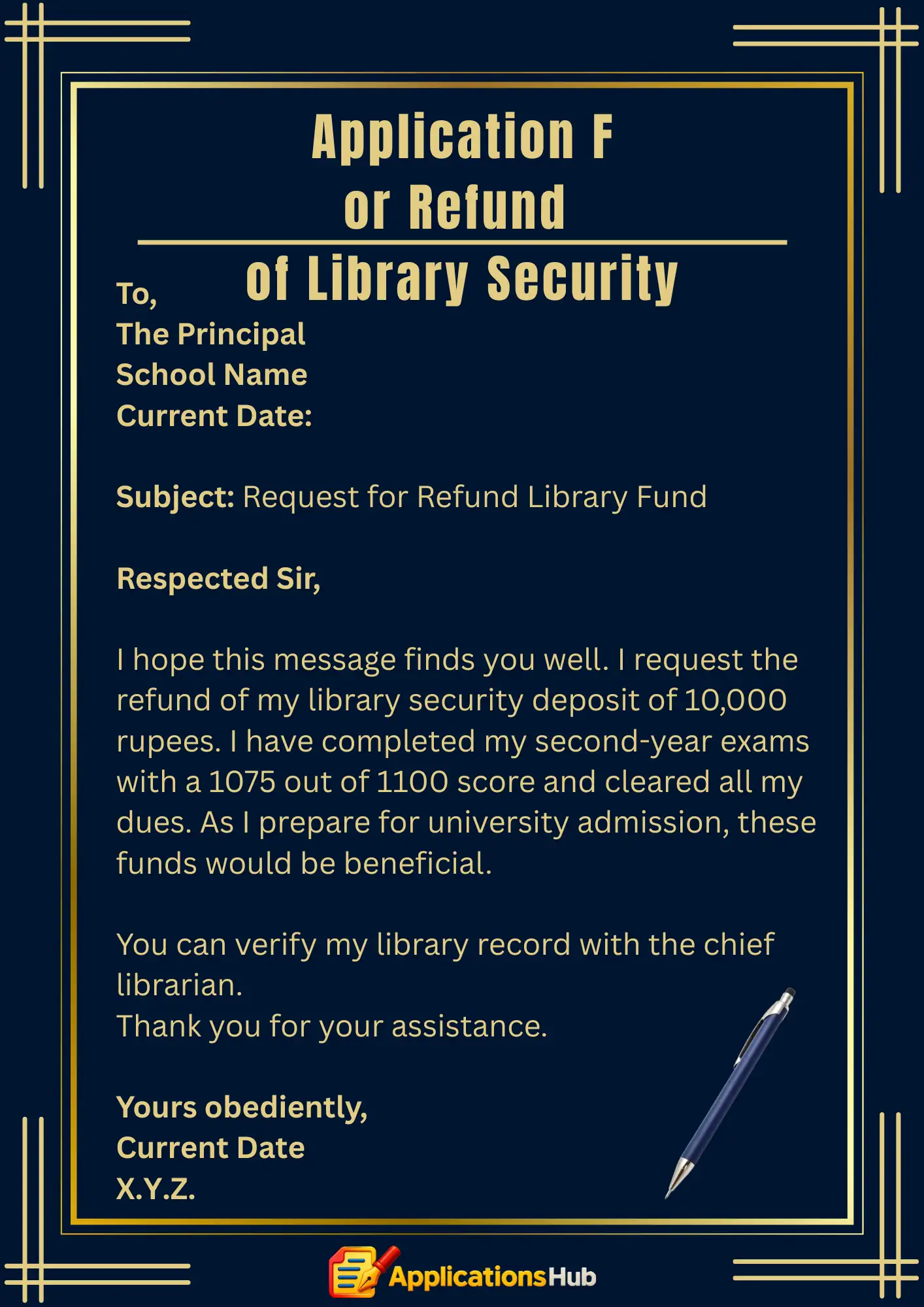How to Write an Application to Refund of Library Security: A Comprehensive Step-by-Step Guide with Sample Reference
Published: 14 Aug 2025
To,
The Principal
[College Name]
[College Address]
Subject: Application for Refund of Library Security Deposit
Dear [Principal’s Name],
I hope this message finds you well. I request the refund of my library security deposit of 10,000 rupees. I have completed my second-year exams with a 1075 out of 1100 score and cleared all my dues. As I prepare for university admission, these funds would be beneficial.
You can verify my library record with the chief librarian.
Thank you for your assistance.
Sincerely,
[Your Signature (if sending a hard copy)]

Writing an application for a refund of library security can seem daunting, but it can be straightforward with a clear structure and proper details. Below is a detailed guide outlining the necessary steps and a sample application for reference.
Complete Step-by-Step Guide
- 1. Understand the Requirements:
- Review your college’s policy regarding library security deposits. Check if there are specific forms or procedures you need to follow to request a refund.
- 2. Gather Necessary Documents:
- Collect any documents needed, such as your library security receipt, student ID, and any correspondence related to your library usage.
- 3. Format Your Application:
- Use a formal letter format. Include your address at the top, followed by the date, and then the Principal’s address.
- 4. Use a Clear Subject Line:
- Clearly state the purpose of your application. A simple subject line such as “Application for Refund of Library Security Deposit” will suffice.
- 5. Write a Polite Salutation:
- Begin your letter with a respectful salutation, such as “Dear [Principal’s Name],”
- 6. Introduce Yourself:
- In the opening paragraph, provide your full name, student ID, the course you are enrolled in, and any additional identification that ties you to the library security deposit.
- 7. State the Purpose:
- Clearly state that you request a refund of your library security deposit. Specify the Amount and include details about when and how the deposit was made.
- 8. Justify Your Request:
- Briefly explain why you are requesting the refund. For example, mention if you have returned all borrowed materials in good condition and fulfilled any other requirements.
- 9. Conclude Respectfully:
- In your closing paragraph, express gratitude for considering your request. Mention that you are looking forward to a prompt response.
- 10. Add a Formal Closing:
- End with a formal closing such as “Sincerely,” followed by your name and signature.
Sample Application
To,
The Principal
[College Name]
[College Address]
Subject: Application for Refund of Library Security Deposit
Dear [Principal’s Name],
I hope this message finds you well. My name is [Your Full Name], and I am currently a [Your Year, e.g., second-year] student in the [Your Course or Department] at [College Name]. My student ID is [Your Student ID].
I am writing to formally request a refund of the library security deposit I paid on [Date of Payment] in the Amount of [Amount]. I have returned all library materials in good condition and have complied with all library policies during my usage period.
I would appreciate your assistance in processing my refund. Thank you for your understanding and support. I look forward to your prompt response.
Sincerely,
[Your Signature (if sending a hard copy)]
Final Tips
- Proofread your application for any grammatical errors or typos.
- Keep a copy of the application for your records.
- Follow up with the administration if you do not receive a response within a week or two.
By following these steps and using the sample as a reference, you can effectively communicate your request for a library security refund.

- Be Respectful
- Stay Relevant
- Stay Positive
- True Feedback
- Encourage Discussion
- Avoid Spamming
- No Fake News
- Don't Copy-Paste
- No Personal Attacks

- Be Respectful
- Stay Relevant
- Stay Positive
- True Feedback
- Encourage Discussion
- Avoid Spamming
- No Fake News
- Don't Copy-Paste
- No Personal Attacks





